RBSE Solutions for Class 11 Chemistry Chapter 5 States of Matter
Rajasthan Board RBSE Solutions for Class 11 Chemistry Chapter 5 States of Matter Textbook Exercise Questions and Answers.
Rajasthan Board RBSE Solutions for Class 11 Chemistry in Hindi Medium & English Medium are part of RBSE Solutions for Class 11. Students can also read RBSE Class 11 Chemistry Important Questions for exam preparation. Students can also go through RBSE Class 11 Chemistry Notes to understand and remember the concepts easily.
RBSE Class 11 Chemistry Solutions Chapter 5 States of Matter
RBSE Class 11 Chemistry States of Matter InText Questions and Answers
Question 5.1.
A balloon is filled with hydrogen at room temperature. it will burst, if pressure exceed 0.2 bar. If at 1 bar pressure, the gas occupies 2.27 L volume, upto what volume can the balloon be expanded?
Answer:
According to Boyle's law, P1V1 = P2V2
P1 = 1 bar, V1 = 2.27 L
If P2 = 0.2 bar then V2 = \(\frac{P_1 V_1}{P_2}\)
If \(=\frac{1 \times 2.27}{0.2}\)
V2 = 1135 L
Question 5.2.
A ship sailing in pacific ocean consists of a balloon which is filled with 2L air, where temperature is 23.4°C; Now, what will be the value of the balloon when the ship reaches Indian ocean, where temperature is 26.1°C ?
Answer:
Given that
V1 = 2L
T2 = 26.1 + 273 = 299.1 K
T (234 + 273) K = 2964 K
From Charles' law,
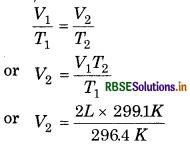
= 2L x 1.0092018 L

Question 5.3
At 25°C and 760 mm of Hg pressure a gas occupies 600 mL volume. What will be its pressure at a height where temperature is 10°C and volume of the gas is 640 mL?
Answer:
Given,
P1 = 760 mm of Hg
V1 = 600 mL
T1 = 25 + 273 = 298 K
P2 =?
V2 = 640 mL
T2 = 10 + 273 = 283 K
According to combined gas Law,
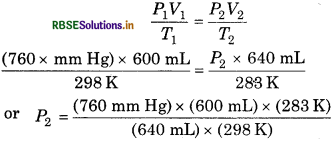
= 6766 mm Hg
Question 5.4.
A neon-dioxygen mixture contains 70.6 g dioxygen and 167.5 g neon. If the pressure of the mixture of gases in the cylinder is 25 bar, what is the partial pressure of dioxygen and neon in the mixture ? (Atomic mass of Ne = 20u)
Answer:
Mass of dioxygen = 70.6 g
Molecular mass of dioxygen = 32 g mol-1
Number of moles of dioxygen = \(\frac{70.6 \mathrm{~g}}{32 \mathrm{~g} \mathrm{~mol}^{-1}}\)
= 2.21 mol
Mass of neon = 167.5g
Molecular mass of neon= 20 g mol-1
Number of moles of neon = \(\frac{167.5 \mathrm{~g}}{20 \mathrm{~g} \mathrm{~mol}^{-1}}\)
= 8375 mol
Mole fraction of dioxygen = \(\frac{n_1}{n_1+n_2}\)
\(=\frac{2.21}{2.21+8.375}\)
\(=\frac{2.21}{10.585}\)
= 0.21
Mole fraction of neon = \(\frac{n_2}{n_1+n_2}\)
\(\begin{aligned} & =\frac{8.375}{2.21+8.375} \\ & =\frac{8.375}{10.585}=0.79 \end{aligned}\)
∵ Partial pressure of gas = mole fraction x total pressure
∴ Partial pressure of dioxygen = 0.21 × (25 bar)
= 5.25 bar
Partial pressure of neon = 0.79 × (25 bar) = 19.75 bar
RBSE Class 11 Chemistry States of Matter Textbook Questions and Answers
Question 5.1.
What will be the minimum pressure required to compress 500 dm3 of air at 1 bar to 200 dm3 at 30°C?
Answer:
Given,
P1 = 1 bar
V1 = 500 dm3
V2 = 200 dm3
P2 =?
From Boyle's law,
P1V1 = P2V2
(1 bar) x (500 dm3) = P2 × (200 dm3)

= 2.5 bar
Question 5.2.
A vessel of 120 mL capacity contains a certain amount of gas at 35°C and 1.2 bar pressure. The gas is transferred to another vessel of volume 180 mL at 35°C. What would be its pressure?
Answer:
Given,
V1 = 120 mL
P1 = 12 bar
V2 = 180 mL
P2 =?
From Boyle's Law,
P1V1 = P2V2
(1.2 bar) x (120 mL) = P2 x (180 mL)

= 0.8 bar

Question 5.3.
Using the equation of state PV = nRT; show that at a given temperature, density of a gas is proportional to gas pressure P.
Answer:
Given,
PV = nRT
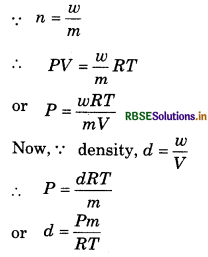
This equation shows that density of a gas is proportional to gas pressure P (d x P).
Question 5.4.
At 0°C, the density of a certain oxide of a gas'at 2 bar is same as that of dinitrogen at 5 bar. What is the molecular mass of the oxide ?
Answer:
Given,
P1 = 2 bar
P1 = 5 bar
M1 =?
M2 =28 (Molecular mass of dinitrogen = 28)
∵ \(d=\frac{P M}{R T}\)
For oxide of gas \(d_1=\frac{P_1 M_1}{R T}\)
For dinitrogen \(d_2=\frac{P_2 M_2}{R T}\)
∵ Density of both gases are same.
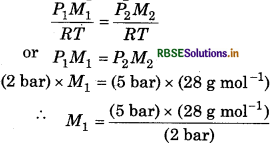
= 70 g mol-1
Question 5.5.
Pressure of 1g of an ideal gas A at 27°C is found to be 2 bar. When 2 g of another ideal gas B is introduced in the same flask at same temperature, the pressure becomes 3 bar. Find the relationship between their molecular masses.
Answer:
At 27°C,
Pressure of 1 g of an ideal gas A = 2 bar
Pressure of 2 g of another ideal gas B = 3 bar
∴Pressure due to gas B = 3 - 2 = 1 bar
From ideal gas equation,
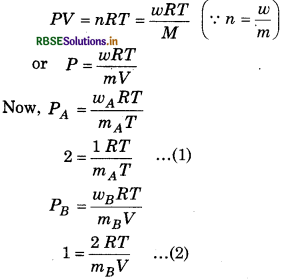
From equation (1) and (2)
\(\frac{2}{1}=\frac{m_B}{2 m_A}\)
MB = 4m A
Question 5.6.
The drain cleaner, Drainex contains small bits of aluminium which react with caustic soda to produce dihydrogen. What volume of dihydrogen at 20°C and one bar will be released when 0.15 g of aluminium reacts?
Answer:
The reaction is written as,
2Al + 2NaOH + 2H2O2 → NaAlO2 + 3H2↑
(27 x 2 = 54) (224 L x 3 at STP = 67.2 L)
∵ 54 g of aluminium gives 67.2 L of H2 at STP
∴ 0.15 g of aluminium will give (V1) = \(\frac{67.2 \times 0.15}{54}\)
= 0.187 L of H2
Given,
P1 =1atm
P1 bar = 0.987 atm
T1 = 273 K
T2 = 273 + 20 = 293 K
V2 =?
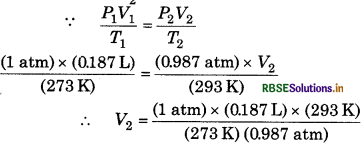
= 0.2033 L
= 2033 mL

Question 5.7.
What will be the pressure exerted by a mixture of 3.2 g of methane and 4.4 g of carbon dioxide contained in a 9 dm3 flask at 27°C ?
Answer:
Mass of methane = 3.2 g
Molecular mass of methane (CH4)
= 12 + 4 = 16
∴ Number of moles of CH4

Mass of Carbon dioxide = 4.4g
Molecular mass of CO2 = 12 + (2 x 16) = 44
∴Number of moles of CO2

Volume of flask (V) = 9 dm3 = 9 x 10 m3
T = 27 + 273 = 300 K
For Methane PCH4 = \(\frac{n R T}{V}\)
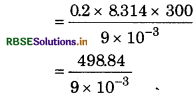
= 5.54 x 104 Pa
For CO2

= 2.77 x 104 Pa
Total pressure exerted by mixture
= PCH4 + PCO2
= 5.54 x 10 + 277 × 104
= (5.54 + 2.77) × 104
= &31× 104 Pa
Question 5.8.
What will be the pressure of the gaseous mixture when 0.5 L of Hg at 0.8 bar and 2.0 L of dioxygen at 0.7 bar are introduced in a 1 L vessel at 27°C?
Answer:
Given, For H2,
V1 = 0.5L
V2 = 1L
P1 = 0.8 bar
P2 =?
From Boyle's law,
P1V1 = P2V2
(0.8 bar) x (0.5 L) = P2 × (1 L)

= 0.4 bar
For O2,
V1 = 20L
V2 = 1L
P1 = 0.7 bar
P2 =?
From Boyle's law,
P1V1 = P2V2
(0.7 bar) x (2.0 L) = \(P_2=\frac{(0.7 \mathrm{bar}) \times(2.0 \mathrm{~L})}{(1 \mathrm{~L})}\) = 1.4 bar
∴ Total pressure of gaseous mixture
= PH2 + PO2 = 0.4 + 14
= 18 bar

Question 5.9.
Density of a gas is found to be 5.46 g/dm3 at 27°C and 2 bar pressure. What will be its density at STP?
Answer:
Given,
∴ We know that,
d1 = 5.46 g dm-3
T1 = 27 + 273 = 300 K
P1 = 2 bar
T2 = 273 K
P2 = 1 bar
d2 =?
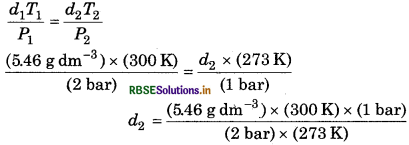
= 3.0 gdm-3
Question 5.10.
34.05 mL of phosphorus vapour weighs 0.0625 g at 546°C and 0.1 bar pressure. What is the molar mass of phosphorus ?
Answer:
R = 0.083 bar dm3 k-1 mol-1
PV = nRT i.e.,n = \(\frac{P V}{R T}\)
\(=\frac{1.0 \mathrm{bar} \times\left(34.05 \times 10^{-3} \mathrm{dm}^3\right)}{0.083 \text { bar } \mathrm{dm}^3 \mathrm{k}^{-1} \times 819 \mathrm{k}}\)
= 5 × 10-4 mol.
∴ Mass of 1 mole = \(\frac{0.0625}{5 \times 10^{-4}}\)
g = 125g
∴ Molar mass = 125 g mol-1.
Question 5.11.
A student forgot to add the reaction mixture to the round bottom flask at 27°C but instead he/she placed the flask on the flame. After a lapse of time, he realized his mistake, and using a pyrometer he found the temperature of the flask to be 477°C. What fraction of air would have been expelled out?
Answer:
Given, T1 = 27 + 273 = 300 K
T2 = 477 + 273 = 750K
From Charles' law,
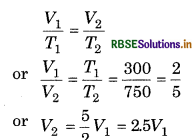
∴ Volume of air expelled out
= 25 V1 - V1
= 1.5 V1
∴ Fraction of air expelled out
\(=\frac{1.5 V_1}{2.5 V_1}=\frac{3}{5}\)
Question 5.12.
Calculate the temperature of 4.0 mol of a gas occupying 5 dm3 at 3.32 bar. (R = 0.083 bar dm3 K-1mol-1).
Answer:
Given
P = 332 bar
V = 5 dm3
R = 0.083 bar dm3 K-1mol-1
n = 4.0
T = ?
From ideal gas equation,
PV = nRT

= 50 K

Question 5.13.
Calculate the total number of electrons present in 1.4 g of dinitrogen gas.
Answer:
Mass of dinitrogen (N) = 1.4g
Molar mass of dinitrogen (N2) = 28
∴ Number of moles of dinitrogen

Total number of electrons present in 0.05 moles of dinitrogen = 0.05 x 6022 × 1023 x 14
= 4.2154 x 1023 electrons
Question 5.14.
How much time would it take to distribute one Avogadro's number of wheat grains, if 1010 grains are distributed each second?
Answer:
∵1010 grains of wheat are distributed in 1 s.
∴ 6.022 × 1023 grains of wheat will be distributed in
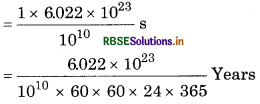
= 190956 x 106 years
Question 5.15.
Calculate the total pressure in a mixture of 8 g of dioxygen and 4 g of dihydrogen confined in a vessel of 1 dm3 at 27° C. R = 0.083 bar dm3 K1 mol-1.
Answer:
For dioxygen,
mass of dioxygen = 8g
molar mass of dioxygen = 32
∴ Number of moles of dioxygen

= 0.25
For dioxygen,
mass of dihydrogen = 4 g
molar mass of dihydrogen = 2
∴ Number of moles of dihydrogen

Total number of moles (n) = 2 + 0.25 = 2.25 moles
V = 1 dm3
T = 27+ 273 = 300 K
R = 0.083 bar dm3 K-1 mol-1
From ideal gas equation,
PV = nRT
∴ \(P=\frac{n R T}{V}\)
\(=\frac{(2.25 \mathrm{moles}) \times\left(0.083 \mathrm{bar} \mathrm{dm}^3 \mathrm{~K}^{-1} \mathrm{~mol}^{-1}\right) \times(300 \mathrm{~K})}{\left(1 \mathrm{dm}^3\right)}\)
= 56.025 bar
Question 5.16.
Pay load is defined as the difference between the mass of displaced air and the mass of the balloon. Calculate the pay load when a balloon of radius 10 m, mass 100 kg is filled with helium at 1.66 bar at 27°C. (Density of air = 12kg m and R = 0.083bar LK-1 mol-1).
Answer:
Given
Radius of balloon (r) = 10 m
P = 1.66 bar
T = 27 + 273 = 300 K
density of air (d) = 1.2 kg m
R = 0.083 bar LK-1 mol-1
Volume of balloon \((V)=\frac{4}{3} \pi r^3\)
\(=\frac{4}{3} \times \frac{22}{7} \times(10)^3\)
= 4190.48 m
Mass of displaced air = density x volume
= 1.2 × 4190.48
= 5028,6 kg
From ideal gas equation,
PV = nRT
\(\begin{aligned} & n=\frac{P V}{R T} \\ = & \frac{(1.66 \mathrm{bar}) \times\left(4190.48 \mathrm{~m}^3\right)}{\left(0.083 \mathrm{bar} \mathrm{L}^{-1} \mathrm{~mol}^{-1}\right) \times(300 \mathrm{~K})} \end{aligned}\)
= 279.36 x 103 moles
Mass of Helium = 279.36 × 103 x 4
= 1117.44 kg
Mass of filled balloon = 100 + 1117.44
= 1217.44 kg
Pay load = 50286 - 1217.44
= 381116 kg

Question 5.17.
Calculate the volume occupied by &8 g of CO2 at 31.1°C and 1 bar pressure. R = 0.083 bar L K1 mol-1.
Answer:
Given, mass of CO2 (W) = 88 g
T = 31.1 + 273 = 3041 K
p = 1 bar
Molar mass of CO2 (M) = 12 + (2 x 16) = 44
R = 0.083 bar LK-1 mol-1
V = ?
Number of moles of CO2,
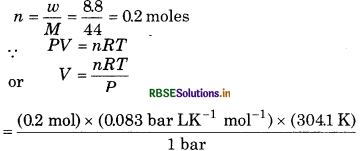
= 5.05 L
Question 5.18.
2.9 g of a gas at 95°C occupied the same volume as 0.184 g of dihydrogen at 17°C, at the same pressure. What is the molar mass of the gas?
Answer:
For a gas,
Mass of gas = 29 g
Let molar mass of gas = M g mol-1
T = 95 + 273 = 368 K
Number of moles of gas \(\frac{2.9}{M}\)
∵ PV = nRT
\(P V=\frac{2.9}{M} \times R \times(368 \mathrm{~K})\) ........... (i)
For dihydrogen,
Mass of dihydrogen = 0.184 g
Molar mass of dihydrogen = 2
T = 17 + 273 = 290 K
Number of moles of dihydrogen = \(\frac{0.184}{2}\)
∵ PV = nRT
\(P V=\frac{0.184}{2} \times R \times(290 \mathrm{~K})\) ...... (ii)
Fromn equation (i) and (ii),

= 40 g mol-1
Question 5.19.
A mixture of dihydrogen and dioxygen at one bar pressure contains 20% by weight of dihydrogen. Calculate the partial pressure of dihydrogen.
Answer:
∵ Mass of dihydrogen in 20% of dioxygen.
So,
Mass of dihydrogen = 20 g
Molar mass of dihydrogen = 2
∴ Number of moles of dihydrogen
\( n_{\mathrm{H}_2}=\frac{20}{2}\)
= 10 moles.
Mass of dioxygen = 80 g
Molar mass of dioxygen = 32
∴ Number of moles of dioxygen
\(n_{\mathrm{O}_2}=\frac{80}{32}\)
= 2.5 moles
Partial pressure of dihydrogen
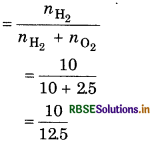
= 0.8 bar
Question 5.20.
What would be the SI unit for the quantity PV2T/n? PV2T2 Nm 2 x (m3)2 × (K)2 mol
Answer:
SI unit of

= Nm4 k2mol-1
Question 5.21.
In terms of Charles' law explain why - 273°C is the lowest possible temperature?
Answer:
From Charles' law,
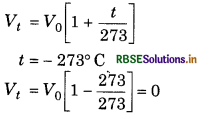
Hence, -273° C is the lowest temperature because below this temperature, the volume will become negative. This is meaningless.
Question 5.22.
Critical temperature for carbon dioxide and methane are 311°C and -819°C respectively. Which of these has stronger intermolecular forces and why?
Answer:
Carbon dioxide has high critical temperature than methane it means that CO2 can be liquified at higher temperature more easily. So, CO has stronger intermolecular forces than methane.
Question 5.23.
Explain the physical significance of van der waals parameters.
Answer:
From van der waals equation,
\(\left(P+\frac{n^2 a}{V^2}\right)(V-n b)\) = nRT
where 'd' and 'b' = van der Waals parameters These parameters depend upon nature of gas.
Significance of 'd':
It gives the magnitude of attractive forces between the gaseous molecules. Its unit is L2mol-2. Greater the value of 'a', greater will be the intermolecular force of attraction between molecules of gas.
Significance of 'b':
It is excluded volume per mol of a gas. Its unit is L1 mol-1. The volume of 'b' is four times the actual volume of the gas molecules.

- RBSE Class 11 Chemistry Important Questions Chapter 2 Structure of Atom
- RBSE Solutions for Class 11 Chemistry Chapter 14 Environmental Chemistry
- RBSE Solutions for Class 11 Chemistry Chapter 13 Hydrocarbons
- RBSE Solutions for Class 11 Chemistry Chapter 12 Organic Chemistry - Some Basic Principles and Techniques
- RBSE Solutions for Class 11 Chemistry Chapter 11 The p-Block Elements
- RBSE Solutions for Class 11 Chemistry Chapter 10 The s-Block Elements
- RBSE Solutions for Class 11 Chemistry Chapter 9 Hydrogen
- RBSE Solutions for Class 11 Chemistry Chapter 8 Redox Reactions
- RBSE Solutions for Class 11 Chemistry Chapter 7 Equilibrium
- RBSE Solutions for Class 11 Chemistry Chapter 6 Thermodynamics
- RBSE Solutions for Class 11 Chemistry Chapter 4 Chemical Bonding and Molecular Structure